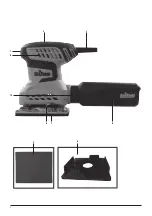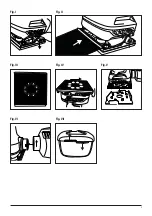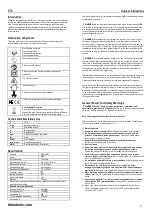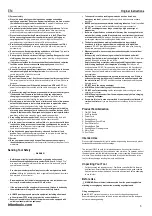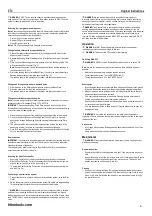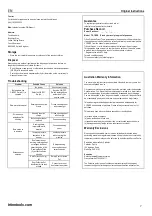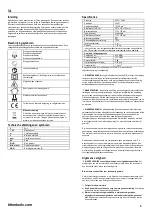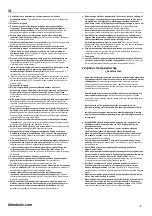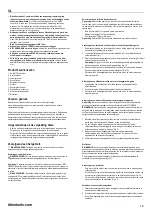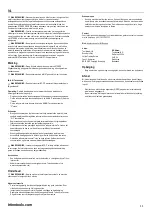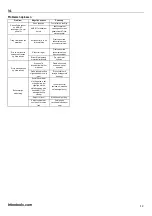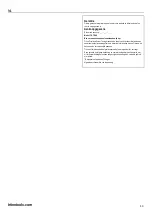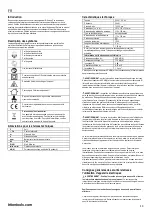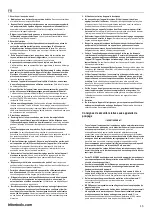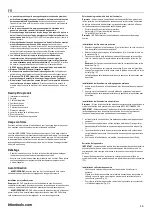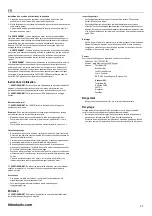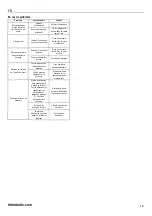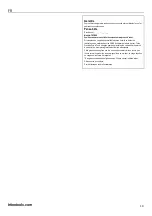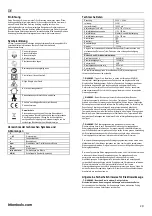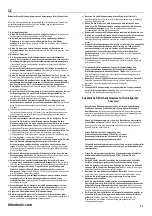
EN
Original Instructions
tritontools.com
6
WARNING:
DO NOT use a sanding sheet on wood that has previously been
used on metal. This may cause scouring on the wooden surface. DO NOT use this
sander for sanding magnesium, or for wet sanding.
Selecting the right grade of sanding sheet
Note:
Always use good quality sanding sheets to maximise the quality of the finished
task. Always test the sander on a scrap piece of material to determine whether the
sanding sheet is suitable for the intended task:
• Coarse (60 grit) for use on rough material
• Medium (120 grit) for smoothing off
• Fine (240 grit) for finishing
Note:
DO NOT use sanding sheets designed for wet sanding.
Fitting standard sheets with pre-punched holes
1. Reduce the rigidity of the sanding sheet (4) by rubbing its smooth side over the
edge of a table (or similar)
2. Release the Sanding Sheet Clamping Levers (8) at the front and rear of the sander
(Fig. I)
3. Place one end of the sanding sheet into a clamp, and close the clamp tightly. This
will secure one end of the sheet (Fig. II)
Note:
Ensure the punched holes in the sanding sheet line up with the openings in
the base of the tool. (Fig. III)
4. Stretch the sanding sheet over the Base Plate (7), and into the other paper clamp.
Keeping the paper taught, clamp the paper tightly (Fig. IV)
• The sanding sheet is now attached to the sander, and the sander ready to use
Fitting hook & loop sheets with pre-punched holes
1. Align the holes on the Sanding Sheet with the holes on the Base Plate
2. Press the sheet onto the hook and loop base plate
• The sanding sheet is now attached to the sander, and the sander ready to use.
Fitting sheets without pre-punched holes
Note:
If you are using conventional sanding sheets with no punched holes, the dust
extraction system of this sander WILL NOT FUNCTION.
IMPORTANT:
Only use the Sanding Punch Plate provided to punch holes in the
Sanding Sheets as sanders vary in the position of the dust extraction holes and using
an incorrect plate will damage the tool.
1. Attach the sheet using one of the methods previously described in this manual
2. On a firm stable surface use the Sanding Sheet Punch Plate (5) to manually
punch holes through the Sanding Sheet by pressing the sander onto the Plate
(Fig. V)
3. The holes should be exactly where the dust extraction holes in the base of the
sander are located. Take care not to damage the surface of the base
4. Once the Sanding Sheet is attached the tool can be used with the Dust Collection
Pot or a compatible dust extraction system
Dust extraction
IMPORTANT
: It is essential to take proper measures to prevent dust entering the motor
and other internal mechanisms of this tool. Failure to do so may seriously reduce the
life and performance of this sander.
This can be done by either connecting the Dust Collection Pot (6) or a suitable dust
extraction system to the Dust Outlet (10).
Attaching the Dust Collection Pot
• Ensure the Collection Pot is empty and clean before attaching to the sander
• Slide the Dust Collection Pot onto the sanders Dust Outlet ensuring the lugs are
aligned, and twist the pot to lock in position (Fig. VI)
• To empty the Dust Collection Pot remove it from the sander and open using the
end tabs (Fig. VII)
Connecting a dust extraction system
1. Connect the sander to a vacuum cleaner, or dust extraction system, using the Dust
Outlet
2. Switch the vacuum cleaner or dust extraction system ON before you begin sanding
• This will significantly reduce the dust in the air around the work area
WARNING:
When sanding metal, ensure your dust extraction system is suitable
and free of any remaining wood dust. Hot metal particles and sparks could ignite
residual wood dust, and cause the dust extraction system to catch fire. Always clean
tools THOROUGHLY when switching from sanding wood to sanding metal, and vice
versa.
WARNING:
Always connect the sander to a suitable vacuum cleaner or
workshop dust extraction system if the sanding dust contains harmful substances,
such as particles from old paint, varnish, surface coatings etc. Always dispose of
harmful dust according to laws and regulations.
WARNING:
Take special care to guard against harmful and toxic dusts when
sanding lead-based painted surfaces, woods and metals, particularly if you are
unsure about the exact substances involved. All persons entering the work area must
wear a mask specially designed for protection against the toxic dust and fumes
involved. Children and pregnant women MUST NOT enter the work area. DO NOT
eat, drink or smoke in the work area.
Operation
WARNING:
ALWAYS wear appropriate personal protective equipment,
including eye protection when working with this tool.
WARNING:
This sander is NOT suitable for wet sanding.
Switching ON & OFF
WARNING:
NEVER touch the Sanding Sheet when the tool is switched ‘ON’.
Note:
Always use clamps to secure your workpiece to the workbench wherever
possible.
• Always grip the sander firmly using the handles provided
• To start the sander, press ‘I’ on the ON/OFF Switch (1)
• To stop the sander, press ‘0’ on the ON/OFF Switch
Sanding tips
• Do not bring the sander into contact with the workpiece until the motor has gained
full speed. Remove the sander from the workpiece before stopping the machine
• Always start with a coarse grit paper, and work through progressively to finer grit
papers until the desired finish is achieved
• Only apply moderate pressure to the sander. Pressing too hard onto the work
surface may overheat the motor or damage the workpiece
• Sand evenly over the work surface; as the machine works in an orbital motion it is
not necessary to work with the grain
• Only use the sander 'flat on’ to the workpiece. Tilting the sander onto its edge will
damage your work
WARNING:
Do not allow the sandpaper to completely wear down before
replacing it. Failure to observe these precautionary measures can lead to damage to
the base of the tool.
Accessories
• A full range of accessories including sanding sheets is available from your Triton
stockist
• Spare parts can be obtained from toolsparesonline.com
Maintenance
WARNING:
Always disconnect from the power supply before carrying out any
maintenance/cleaning.
General inspection
• Regularly check that all the fixing screws are tight. They may vibrate loose over
time
• Inspect the supply cord of the tool, prior to each use, for damage or wear. Repairs
should be carried out by an authorised Triton service centre. This advice also
applies to extension cords used with this tool
Cleaning
• Keep your tool clean at all times. Dirt and dust will cause internal parts to wear
quickly, and shorten the tool’s service life. Clean the body of your tool with a soft
brush, or dry cloth. If available, use clean, dry, compressed air to blow through
the ventilation holes
Содержание TQTRSS
Страница 2: ...2 3 2 10 1 9 5 7 4 8 6...
Страница 3: ...3 Fig II Fig I Fig III Fig V Fig IV Fig VI Fig VII...
Страница 51: ...RU tritontools com 51 1 a b c 2 a b c d e f g 30 3 a b c d e f g h 4 a b c d e f g h 5 30 a FFP2...
Страница 54: ...RU tritontools com 54 1 Triton 7 6...
Страница 55: ...RU tritontools com 55...
Страница 56: ......


